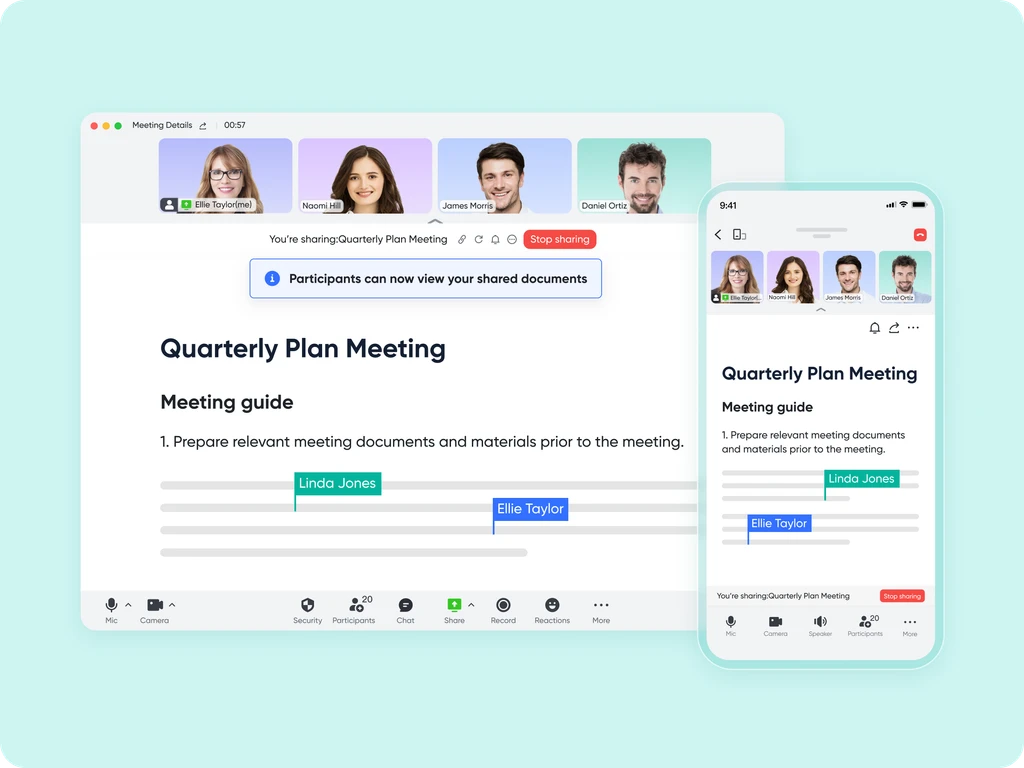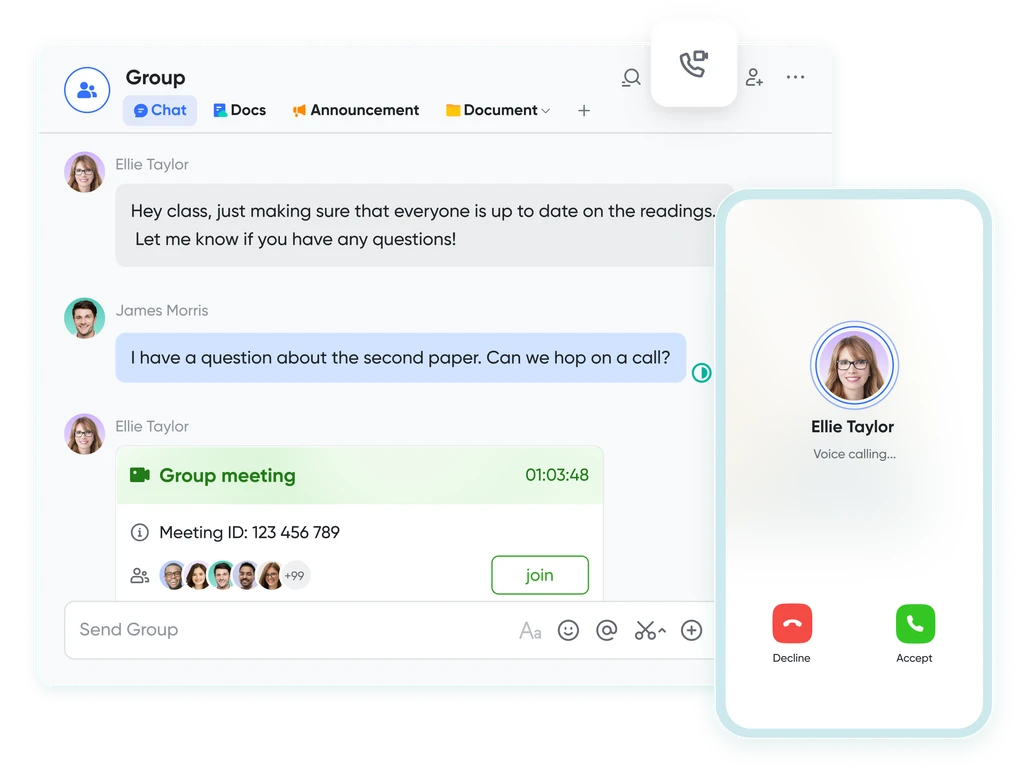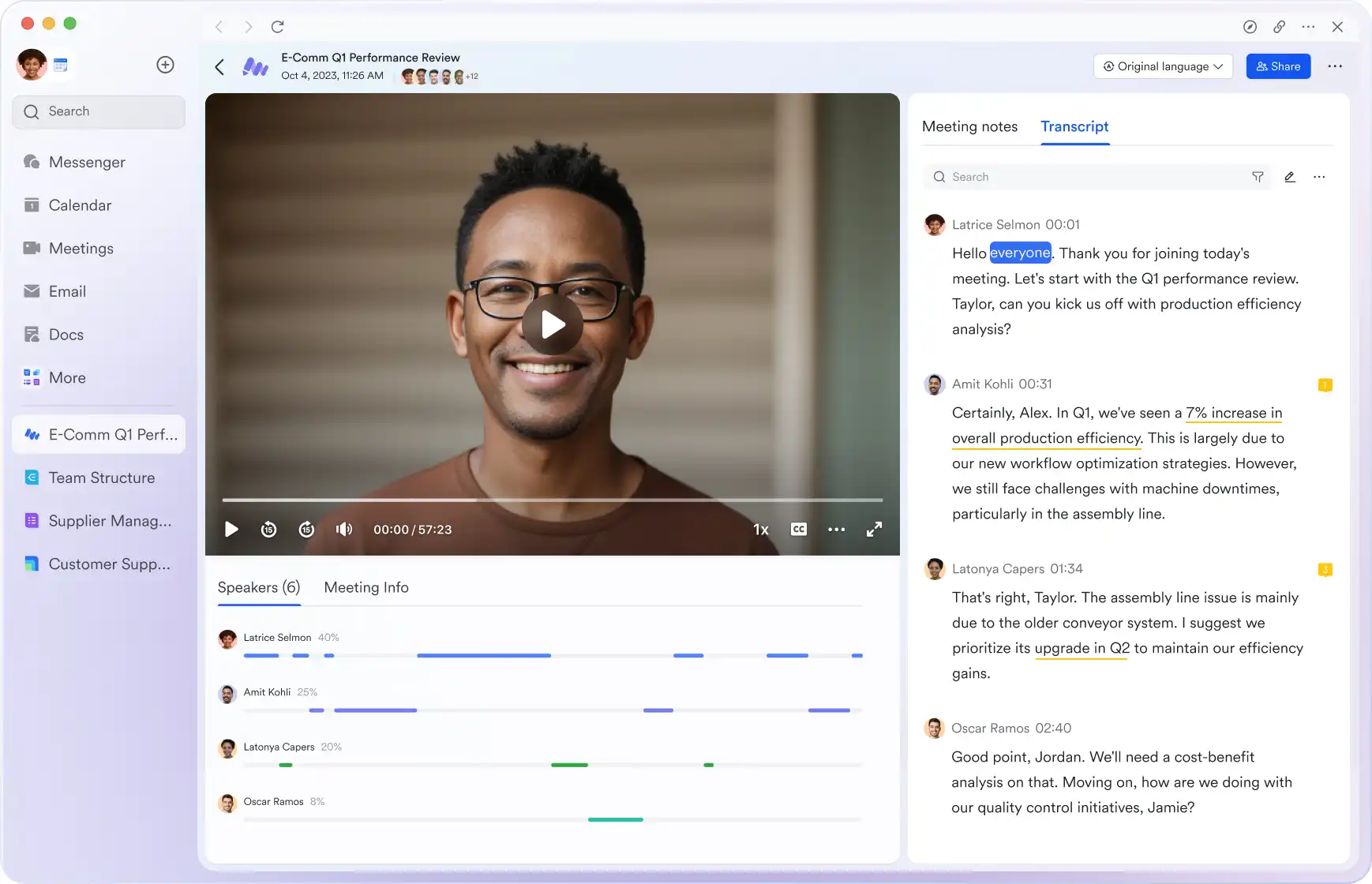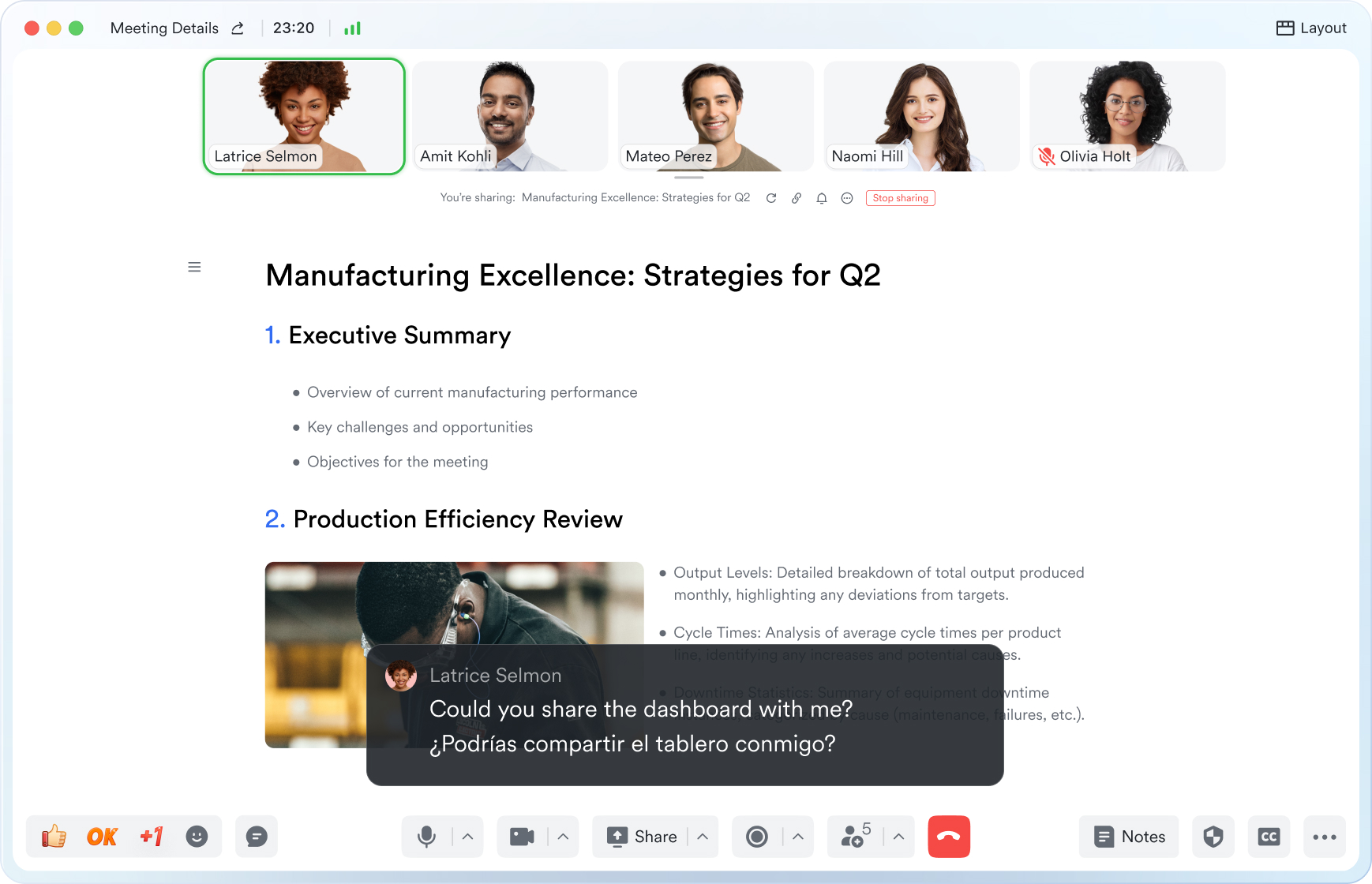Sprint Planning Meeting
This guide will walk you through the essential elements of use sprint planning meeting to keep your attendees aligned and engaged.
Try Lark for Free
In the ever-changing landscape of software development and project management, the sprint planning meeting remains a crucial element in ensuring team alignment, task clarity, and achievable sprint objectives. As we move further into 2024, it's essential for teams to adapt and refine their approach to sprint planning meetings to optimize their effectiveness and productivity.
Use Lark Meetings to turn meetings into true collaborative experiences.
What is a sprint planning meeting?
A sprint planning meeting is a recurring event in Agile project management that marks the beginning of a new sprint. Its primary purpose is to determine and commit to the sprint goal, discuss and select the backlog items to be included in the sprint, and create a plan that guides the team's work during the sprint.
Goals of sprint planning meeting
The primary goals of a sprint planning meeting are to establish a shared understanding of the sprint goal, select and commit to the appropriate backlog items, and develop a sprint backlog that outlines the specific tasks and activities needed to achieve the sprint goal effectively.
Who should attend sprint planning meeting?
Key participants in a sprint planning meeting typically include the Scrum Master, product owner, and the entire Scrum team. Additionally, other stakeholders or subject matter experts may be involved based on the nature of the sprint.
-
Scrum Master: Facilitates the meeting, ensures adherence to the Scrum framework, and promotes productive collaboration.
-
Product Owner: Provides insights into the product backlog, clarifies requirements, and helps set sprint goals and priorities.
-
Scrum Team: Shares insights, provides task estimations, and collaborates to define the sprint backlog.
Learn more about Lark x Meetings
Topics, agenda, and structure of sprint planning meeting
Setting the Stage
The meeting should commence with a brief introduction to reiterate the purpose of the sprint planning, reinforcing the focus on achieving the sprint goal and the nature of the backlog items to be discussed.
Reviewing the Product Backlog
This segment involves a comprehensive review of the product backlog items. Product owner and team members discuss the items and their priority, striving for a shared understanding of the work to be undertaken.
Collaborative Estimation
Team members collectively discuss the effort required for each backlog item, providing task estimation using techniques such as planning poker to ensure alignment on the workload.
Capacity Planning
Based on the team's velocity and availability, the Scrum team collaborates to select and commit to a set of backlog items that can be realistically completed within the sprint timeframe.
Creating the Sprint Backlog
Once commitments are made, the team creates a plan detailing the tasks and activities necessary to achieve the sprint goal.
Learn more about Lark x Meetings
How often does a sprint planning meeting occur?
Sprint planning meetings are typically held at the beginning of each sprint, ensuring that the team is adequately prepared to execute the work agreed upon and achieve the defined sprint goal within the sprint duration, usually a two-week period.
Key difference between sprint planning meeting and another similar meeting
One common comparison is between sprint planning meetings and sprint review meetings. While both are essential in Agile methodologies, they serve distinct purposes. The sprint planning meeting focuses on determining how the team will achieve the sprint goal, while the sprint review meeting is geared towards assessing the work completed during the sprint and gathering feedback for the next steps.
Learn more about Lark x Meetings
Three practical examples of sprint planning meeting
Example 1: aligning stakeholders and team members
Example 1: aligning stakeholders and team members
In a software development project, the sprint planning meeting involved transparent discussions between the product owner, development team, and key stakeholders to set sprint objectives and to align the backlog items with the business priorities.
Example 2: task estimation in action
Example 2: task estimation in action
During a sprint planning meeting, a development team used task estimation techniques to assign relative sizes to backlog items, facilitating a balanced workload distribution and fostering team collaboration.
Example 3: capacity-driven commitments
Example 3: capacity-driven commitments
In another instance, a Scrum team leveraged their velocity data to make informed commitments in the sprint planning meeting, ensuring an achievable plan aligned with their capacity.
Common pitfalls of a sprint planning meeting
While sprint planning meetings are instrumental in setting the stage for a successful sprint, several common pitfalls can undermine their effectiveness.
- Insufficiently groomed or poorly prioritized product backlog
- Lack of active participation from team members
- Overestimation or underestimation of task efforts
- Failure to consider team capacity and velocity
- Overly ambitious or vague sprint goals
Learn more about Lark x Meetings
Dos and don’ts of a sprint planning meeting
| Do | Don't |
|---|---|
| Clearly define the sprint goals and objectives | Rush through the task estimation process |
| Encourage active participation and collaboration | Overcomplicate the agenda with unnecessary details |
| Schedule regular breaks for long meetings | Dictate rather than facilitate the planning process |
| Set clear and achievable sprint commitments | Overlook team capacity and individual workload |
What makes a virtual sprint planning meeting successful?
In the modern professional landscape, the rise of virtual meetings has transformed the way teams collaborate. To ensure the success of a virtual sprint planning meeting, clear communication, effective use of collaboration tools, and structured agendas are essential. Moreover, creating engagement opportunities and replicating the dynamics of in-person discussions are vital for virtual meetings to be successful.
Learn more about Lark x Meetings
Typical takeaways of the sprint planning meeting
A successful sprint planning meeting results in a clear sprint goal, a full understanding of the selected backlog items, a commitment to achievable tasks, and a structured sprint backlog that guides the team's work. Additionally, it fosters team alignment, commitment, and a renewed sense of purpose for the upcoming sprint.
Questions to ask in the sprint planning meeting
- What are the primary objectives for this sprint?
- How do the selected backlog items contribute to the sprint goal?
- What impediments or dependencies should be considered during the sprint?
- How can the team leverage its capabilities to achieve the sprint goal effectively?
- Are there any capacity constraints or considerations that may impact the sprint commitment?
Learn more about Lark x Meetings
Conclusion
In conclusion, a well-executed sprint planning meeting is the foundation for a successful sprint, providing clarity, commitment, and alignment to the team's objectives. By adhering to the best practices, adapting to virtual settings, and learning from practical examples and pitfalls, teams can enhance the effectiveness of their sprint planning meetings, paving the way for more successful sprints and project deliveries.
Use Lark Meetings to turn meetings into true collaborative experiences.
A Game Changer for Sprint Planning Meeting: Empower your team with Lark Meetings
In the fast-paced and dynamic world of modern business, effective communication and collaboration are crucial for success of Sprint Planning Meeting. Here we introduce Lark Meetings to serve as a centralized hub for all communication needs.
Transform your meetings into collaborative endeavors

Leverage the potency of in-call document sharing, intelligent meeting minutes, and mobile-optimized features to enhance productivity collaboratively, irrespective of your location or schedule.
Seamlessly collaborate in real-time, across any device

Share live documents instead of just screen views. Participants can navigate and edit simultaneously within the video call window, even while on the move.
Shift your focus to engagement, not note-taking

Lark Minutes automatically converts video meetings into transcripts, facilitating easy viewing, searching, and collaborative editing. Stay in the loop asynchronously, even if you can't attend the live meeting. Lark Minutes for meeting minutes support translation into 10+ different languages.
Break language barriers in communication

Lark Meetings provide real-time translation for subtitles, allowing individuals from diverse backgrounds to express themselves in their native languages. Ensure every voice is heard, regardless of geographical location. Live subtitles currently support translations from English, Chinese, and Japanese to 10+ different languages. See more translation feature in Lark.
Connect with larger audiences
Host dynamic online meetings and events accommodating up to 1,000 participants, with the flexibility of up to 50 breakout sessions for intimate group discussions within the larger meeting context. Try more Lark features for free.








